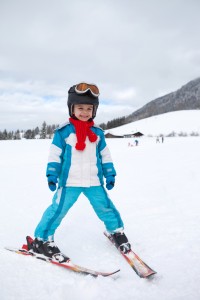
Temperatures are dropping and snow is beginning to accumulate on mountaintops across the country. It’s that time of year again; time to dust off those skis or snowboards and hit the slopes. But before hopping on the chair lift, parents should talk to their kids about safety.
Winter sports, although fun, come with inherent risks – cold temperatures, potentially rugged terrain and the possibility of serious injury. Dr. Tony Woodward, medical director of Emergency Services at Seattle Children’s, offers tips to help kids enjoy the slopes safely.
“Safety starts with anticipating risk,” said Woodward. “When you don’t anticipate risk, you aren’t putting yourself in the best situation, and that’s when injury can occur.”
Start by bundling and gearing up
Before a child hits the slopes, it’s important to make sure they have the right gear, both for their safety and comfort.
Ensure a child’s time on the slopes is safe by ensuring their gear is properly fitted. Skis, bindings, snowboards, boots, poles and helmets should be uniquely fitted to a child.
Skis or Snowboard – Make sure a child’s skis or snowboard are the right size for their height, weight and skill level. Also make sure they are in good condition and are made for the expected snow conditions.
Bindings – Bindings are important because they release when a child falls, and if not adjusted properly, bindings can cause injury. They need to release when a child takes a tumble, but shouldn’t release too easily or they can cause a tumble of their own.
Boots – Proper ski or snowboard boots keep a child’s feet warm, comfortable and in control of their skis or board. Make sure boots fit; boots that are too big or too small can be problematic, according to Woodward.
Poles – Like other ski equipment, poles should be fitted based on a child’s height. Turn one pole upside down and have the child hold it by the tip, with a hand resting on the basket. The child’s elbow should be at a right angle with the handle of the pole touching the ground.
Helmet – Children should always wear a helmet when skiing or boarding! Helmets protect a child’s head and can help prevent life-threatening injuries.
“It’s really important to have a helmet that fits well,” said Woodward. “Wearing a helmet should be mandatory, just like when riding a bike. We would never think about playing football or ice hockey without wearing a helmet. Skiing and snowboarding should be the same. Always wear one!”
Woodward also advises parents to model good behavior, as children are more likely to wear a helmet if a parent wears one as well.
“Make wearing a helmet fun,” said Woodward. “Personalize a child’s helmet, or add stickers to them to make them more fashionable. But make sure you check helmet instructions to make sure putting stickers on a helmet doesn’t change it’s effectiveness.”
Goggles and sunglasses – The sun’s rays can be a danger on the slopes. Sunglasses can help protect a child’s eyes from rays bouncing off the white snow. For protection from the cold, wind, snow and objects like branches, goggles are best. Goggles and sunglasses should also offer UV protection and be impact resistant, according to Woodward.
Proper gear is needed, but proper clothing can make or break a child’s ski experience on the slopes. Keep them properly bundled for winter weather conditions, which can change quickly. Not enough clothing can cause a child to become too cold, and can lead to hypothermia or frostbite. Too many clothes on a sunny day can make a child sweat, which can lead to chills when the sun goes away. It’s best to dress in layers to avoid both issues.
“It’s easy to add and subtract layers,” said Woodward. “During cold mornings bundle up, but as temperatures get warmer children can easily lose layers.”
Woodward also advises parents to check in with kids about how they’re feeling.
“Children don’t recognize cold as well,” said Woodward. “If the inside of a child’s glove gets wet on a cold day, it can be lead to frost nipped fingers. Remember to check in regularly with children.”
Safety checks
When skiing or snowboarding in unfamiliar terrain, Woodward recommends using caution and supervising children. Always stay with a group, be aware of a child’s limits and abilities, follow the rules of the ski area and be mindful of others.
“Adolescents can be at greater risk because they think they are invincible,” said Woodward. “Make sure to set boundaries with your children and teens before skiing or snowboarding.”
Remember to follow signs and directions, don’t travel into unmarked areas and insist children and teens only use runs that match their ability level – green (beginner), blue (intermediate) and black (expert).
Need a helmet for winter sports? The Kohl’s Helmet Safety Program at Seattle Children’s hosts FREE Winter Sport Helmet Fitting and Giveaways. The Kohl’s Helmet Safety Program is a year-round community outreach program focused on reducing preventable head injuries in children through free helmet fitting and giveaway events.

